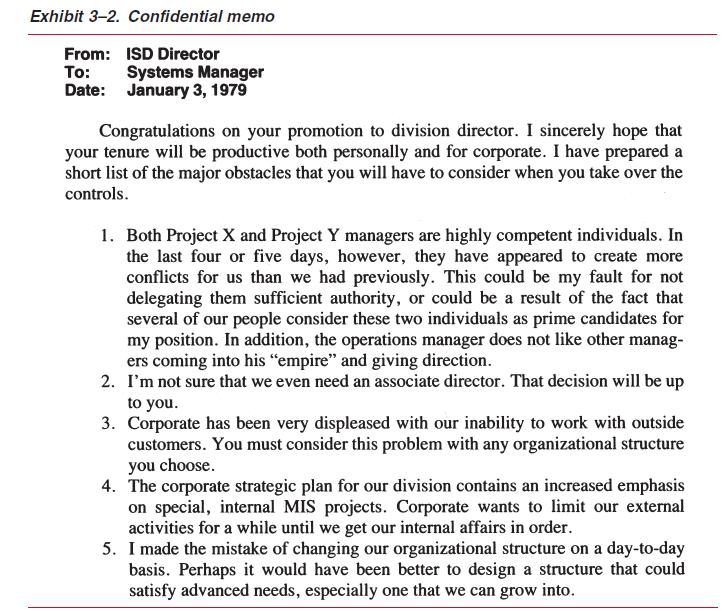By 1970, Jones and Shephard Accountants, Inc. (J&S) was ranked eighteenth in size by the American Association
Question:
By 1970, Jones and Shephard Accountants, Inc. (J&S) was ranked eighteenth in size by the American Association of Accountants. In order to compete with the larger firms, J&S formed an Information Services Division designed primarily for studies and analyses. By 1975, the Information Services Division (ISD) had fifteen employees.
In 1977, the ISD purchased three minicomputers. With this increased capacity, J&S expanded its services to help satisfy the needs of outside customers. By September 1978, the internal and external workloads had increased to a point where the ISD now employed over fifty people.
The director of the division was very disappointed in the way that activities were being handled. There was no single person assigned to push through a project, and outside customers did not know whom to call to get answers regarding project status. The director found that most of his time was being spent on day-to-day activities such as conflict resolution instead of strategic planning and policy formulation.
The biggest problems facing the director were the two continuous internal projects (called Project X and Project Y, for simplicity) that required month-end data collation and reporting.
The director felt that these two projects were important enough to require a full-time project manager on each effort.
In October 1978, corporate management announced that the ISD director would be reassigned on February 1, 1979, and that the announcement of his replacement would not be made until the middle of January. The same week that the announcement was made, two individuals were hired from outside the company to take charge of Project X and Project Y. Exhibit 3–1 shows the organizational structure of the ISD.
Within the next thirty days, rumors spread throughout the organization about who would become the new director. Most people felt that the position would be filled from within the division and that the most likely candidates would be the two new project managers. In addition, the associate director was due to retire in December, thus creating two openings.
On January 3, 1979, a confidential meeting was held between the ISD director and the systems manager.
ISD Director: “Corporate has approved my request to promote you to division director.
Unfortunately, your job will not be an easy one. You’re going to have to restructure the organization somehow so that our employees will not have as many conflicts as they are now faced with. My secretary is typing up a confidential memo for you explaining my observations on the problems within our division.

“Remember, your promotion should be held in the strictest confidence until the final announcement later this month. I’m telling you this now so that you can begin planning the restructuring.
My memo should help you.” (See Exhibit 3–2 for the memo.)
The systems manager read the memo and, after due consideration, decided that some form of matrix would be best. To help him structure the organization properly, an outside consultant was hired to help identify the potential problems with changing over to a matrix. The following problem areas were identified by the consultant:
1. The operations manager controls more than 50 percent of the people resources. You might want to break up his empire. This will have to be done very carefully.
2. The secretary pool is placed too high in the organization.
3. The supervisors who now report to the associate director will have to be reassigned lower in the organization if the associate director’s position is abolished.
4. One of the major problem areas will be trying to convince corporate management that their change will be beneficial. You’ll have to convince them that this change can be accomplished without having to increase division manpower.
5. You might wish to set up a separate department or a separate project for customer relations.

6. Introducing your employees to the matrix will be a problem. Each employee will look at the change differently. Most people have the tendency of looking first at the shift in the balance of power—have I gained or have I lost power and status?
Questions
1. What should the new organizational structure look like? Where should I put each person, specifically the managers?
2. When should I announce the new organizational change? Should it be at the same time as my appointment or at a later date?
3. Should I invite any of my people to provide input to the organizational restructuring? Can this be used as a technique to ease power plays?
4. Should I provide inside or outside seminars to train my people for the new organizational structure? How soon should they be held?
Step by Step Answer:

Project Management A Systems Approach To Planning Scheduling And Controlling
ISBN: 9780471741879
9th Edition
Authors: Harold Kerzner





